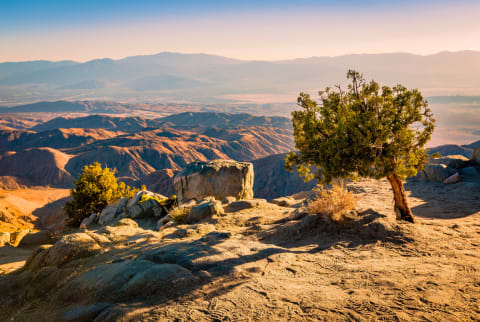Advertisement
A Look Inside The California Water Crisis That Nobody's Talking About


For passers-by, it would be easy to miss the moderate-size cylinder jutting out of a field in rural California. But to Carol Rowland and her husband, this metal tank dictates their daily routine. When the water runs low, they go without.
"We have no lawns, no vegetable garden. We wear clothes longer and wash them less often. We take quick showers or a shallow bath but not every day," Rowland tells mbg of the water-saving measures she has put in place in her household. "Every year, we just pray we can get through the summer."
A state run dry.
The Rowlands are two of an estimated 500,000 to 1 million people in California's central valley who have trouble accessing water, or whose water doesn't meet federal clean water drinking standards1. Retirees who have lived in their home in San Luis Obispo County, California, since 1974, they first noticed the well on their property start to run dry in 2013, in the midst of California's infamous six-year drought. It was around this time that new large-scale farms, mostly vineyards, were popping up in droves around them. Their county held special appeal for growers because of its position right above one of the state's largest aquifers, a source of groundwater that allowed for fertile soil independent of the state water system.
"We are receiving state water, but we never became dependent on it. Looking back now, that's a good thing because the state water system rarely delivers on even half of its contracted water," reveals Debbie Arnold, a supervisor in Rowland's district.
Geography, politics, and an uncooperative climate have converged to make California's water system—the most engineered one in the world—unpredictable at best and dangerous at worst.
First constructed in the 1960s, the state's maze of tunnels and dams carry melted snowfall and freshwater from Northern California, where two-thirds of water falls, down to the drier southern part of the state. Along the way, it passes through the central valley to be used for agriculture (California produces an estimated 25 percent of food sold in the United States, more than any other state). But during times of severe drought, likely exacerbated by climate change, these carrier systems are overtapped, which can lead residents and growers to scramble for water for their farms and families.
The idea that water is the ultimate renewable resource dies really hard.
In the case of Rowland's town, farmers continue to drill deeper and deeper to access the dwindling groundwater supply, with little regulation in place to stop them. "We've seen what I call an influx of agricultural investment—that's more of a corporate investment moving into the county in a really big way and spending a lot of money to purchase property and farm it. We saw the demand increasing while the water table was going down," says Supervisor Arnold. This leaves residents like the Rowlands, who can't afford to drill any deeper and can't sell a house that doesn't have a reliable water source, at a standstill.
Across the state of California, over 300 systems carry water that has been contaminated by agricultural runoff or naturally occurring pollutants like arsenic and uranium. "Poor communities who work on the farms don’t have infrastructure in place to clean that groundwater. Those are the people getting the shortest end of the stick," explains Jared Blumenfeld, who served as a California regional administrator for the Environmental Protection Agency under President Obama.
The crisis in California draws forth some of the biggest environmental questions of today. Namely, how do we feed a growing world while protecting the land and people that make our food? And can capitalism exist in a way that doesn’t harm vulnerable populations? It's a case study in what can happen when human needs exceed nature's ability to keep up, and unfortunately it's one of many.
Water is not a renewable resource.
To Christiana Zenner, Ph.D., an author and professor of water ethics at Fordham University, California's crisis speaks to the need for a new way of thinking about natural resources. "So much of the agricultural and industrial and domestic use of fresh water has been built on groundwater supplies; those groundwater supplies were viewed as renewable for most of the 20th century," she tells mbg. "What we’ve realized is that a lot of these resources are not renewable in the way we thought. But the idea that water is the ultimate renewable resource dies really hard."
Zenner points to highly publicized water access fights like those in Flint, Houston, and Puerto Rico, as further proof that safe water can indeed disappear, and we need to construct systems to protect those most at risk when it does. "People who exist at the margins of social or economic status, whether because of race or class or immigration status, tend the bear the negative brunt of the impact in the most profound ways," she says, pointing to Native American tribes as the perfect example. "The significant majority of Native American populations on reservations do not have hookups for fresh water. They have to have water trucked in. But it’s kind of an invisible problem."
"Water quality is of great concern to California’s Tribal governments not only for personal consumption, but also for the long term health and restoration of cultural habitats for traditional plants and animal life, ecosystems for healthy fish population, and access to traditional plants for food and ceremonial use," adds Anecita Agustinez, a Tribal Policy Advisor at California's Department of Water Resources.
However, as word about disenfranchised communities continues to make headlines and the next generation of environmental and social activists—who Zenner says are unwilling to "accept status quo bullshit"—continues to speak up, she is confident we can find solutions. But such a convoluted problem calls for a wide net of new policies, actions, and attitudes. "I basically think that one-size-fits-all solutions to water crises are impossible," she warns.
How California is responding.
In California, the policy portion of the puzzle is slowly taking shape. In 2014, state governor Jerry Brown signed a law requiring property owners in over-drafted areas to submit a plan for sourcing their water more sustainably. However, these plans won't be due until 2020 at the earliest, giving landowners plenty of time to either continue as is or start making change.
Though in 2015 farmers dug more wells in the Central Valley than during any other year on record, Blumenfeld has also noticed plenty of positive momentum starting to build around the state. "There’s been this divisive conversation saying 'It’s ag's fault.' But at the end of the day, we do need to eat food and it does come from there. Could the agriculture industry do more? Yes. Are they now being forced to do more? Yes. They’re feeling a squeeze too," he says.
For glimpses into a less resource-intensive future for California, you can look to the coastal county of Marin, where the Carbon Cycle Institute is teaching farmers how to conserve water by improving soil health. Their research has found a direct link between soil's carbon content and its ability to retain water. Using methods like planting shrubs, fertilizing with compost, and moving cover crops, the Institute has been able to keep carbon out of the atmosphere and in the soil, where it can better conserve water. "We started out in one county, and now we're working in 30," says executive director Torri Estrada. "And we’re just one small organization. That’s a pretty huge uptick, and frankly we have a ton of interest from producers. The challenge will be the cost of implementing these practices. Often, producers can’t afford it up front."
A regenerative future.
Josh Tickell, whose new book, Kiss the Ground, explores the potential of regenerative farming practices like these to transform agriculture as we know it, told mbg late last year, "The biggest misconception about U.S. agriculture is that we can somehow make it work without dealing with the soil." If tended to correctly, he believes that soil can be the ultimate tool in climate cleanup. Major food corporations like EPIC, a line of meat products, and Annie's, the popular mac-and-cheese purveyor, both owned by General Mills, have recently hopped on the carbon-sequestration bandwagon and committed to regenerative practices, signaling a new wave of sustainable food beyond the organically grown label.
Everything is connected, and it all requires simultaneous unraveling.
While it may seem like supporting farms that prioritize soil health won't make a difference in such massive water issues, the experts disagree. "Our water crisis isn’t happening in a vacuum," says Adam Keats, a senior attorney entrenched in California's water rights cases. "It's related to agriculture, business, and climate change. Everything is connected, and it all requires simultaneous unraveling."
How you can get involved.
Snowfall in the Sierra mountains of Northern California remains light as winter draws to a close, signaling what could be another long, dry summer for those down south.
"I hope people wake up in time. We need to realize we can't keep doing this, because there are consequences. This is just our version of it in one little corner of the world," Carol Rowland said during her appearance in Water & Power: A California Heist, a recent documentary on the water access issue. Rowland has since become an everyday activist in her county, standing up to protect water rights for families who have lived in the community for years. Her advice for anyone looking to help out? Simply join the conversation. "Talk to people about the water situation to help raise awareness. Use social media to share your thoughts with others on water issues. Sign carefully thought-out petitions when pertinent and from a reliable source."
Zenner agrees that at the end of the day, we should all be taking individual action and broadcasting our own voices and experience for all to hear: "Water is such a source of connection to people. Everyone has experiences of water that are universal in some sense but also radically particular. It’s an area where analysis and creativity are essential."
Never has there been a more important time to vote with your dollar and support farmers who are doing good work. No matter where you live, ask where your food is coming from and how it was grown. Think twice about what you're putting into your body—and what you're putting in the trash. "Going meat-free one day a week or going totally meat-free is probably the largest thing you can do," advises Blumenfeld. "You always hear about almonds and fruit that requires a lot of water to grow, but when you do an analysis of anything compared to a hamburger, it’s incredible. Another thing you can do is buy a smaller refrigerator so you waste less. Twenty-five percent of all the fresh water in the U.S. goes to making food that we throw away. Instead, start a small composting program in your community so trash goes back to soil and soil health." Beyond that, if you are lucky enough to live in a place where water access issues feel far away, hold onto the mindset that every drop counts and be conscious of how long you let your tap run when you're bathing and cleaning.
Stay up to date with water access issues across the country here, support organizations fighting for clean water like the NRDC and Sierra Club. Then, read up on how to support climate-friendly agriculture and how to be an effective activist.
1 Source
Watch Next
Enjoy some of our favorite clips from classes
Enjoy some of our favorite clips from classes
What Is Meditation?
Mindfulness/Spirituality | Light Watkins
Box Breathing
Mindfulness/Spirituality | Gwen Dittmar
What Breathwork Can Address
Mindfulness/Spirituality | Gwen Dittmar
The 8 Limbs of Yoga - What is Asana?
Yoga | Caley Alyssa
Two Standing Postures to Open Up Tight Hips
Yoga | Caley Alyssa
How Plants Can Optimize Athletic Performance
Nutrition | Rich Roll
What to Eat Before a Workout
Nutrition | Rich Roll
How Ayurveda Helps Us Navigate Modern Life
Nutrition | Sahara Rose
Messages About Love & Relationships
Love & Relationships | Esther Perel
Love Languages
Love & Relationships | Esther Perel











